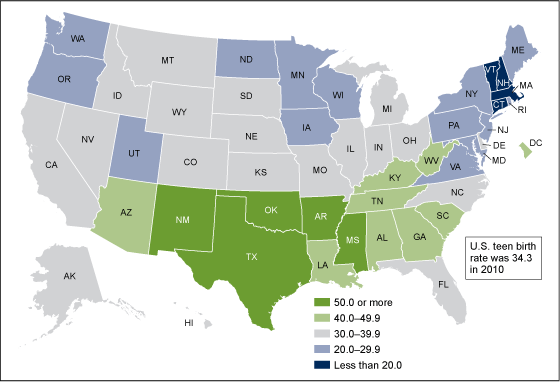
While the teen birth rate in the United States continues to decline, it is still relatively high compared to other industrialized nations. Research has demonstrated that teen mothers are less likely to finish high school, more likely to live in poverty and remain unmarried, and that their children will, on average, face a variety of challenges. But questions remain about whether teen births are the cause or effect of reduced socioeconomic advantage.
A 2012 paper from researchers at the University of Maryland and Wellesley College for the National Bureau of Economic Research, “Why Is the Teen Birth Rate in the United States so High and Why Does It Matter?” analyzes five survey data sources, including the Vital Statistics survey and the National Surveys of Family Growth. The researchers also review many of the most important prior studies on the issue and evaluate their insights.
The study’s findings include:
- In 2010 the U.S. had a teen pregnancy rate of 34.3%. The typical rate for a developed country is less than 20%.
- The U.S. teen birth rate was 50 to 55 births per 1,000 women through the 1970s and 1980s, rising to nearly 60 births per 1,000 women in the early 1990s. It has declined since then.
- “U.S. teens are two and a half times as likely to give birth as compared to teens in Canada, around four times as likely as teens in Germany or Norway, and almost 10 times as likely as teens in Switzerland. Among more developed countries, Russia has the next highest teen birth rate after the United States, but an American teenage girl is still around 25 percent more likely to give birth than her counterpart in Russia.”
- Based on 2007-2009 survey data, 36% of U.S. teens are sexually active, with rates varying from 28% in Colorado and Vermont to more than 45% in Georgia and Mississippi.
- Teen birth rates cannot be explained by variations in abortion rates, as the abortion rate was approximately 20% to 25% in the mid-1990s and has been relatively stabile since then.
- Sexually active female teens who are not using contraception frequently give contradictory answers to related questions, indicating “a general sense of ambivalence toward becoming pregnant.”
- Among sexually active teens, contraceptive use ranges from more than 90% in Maine, New Hampshire, and Vermont, which are among states with the lowest teen birth rates, to 81% in Texas and New Mexico, which are among states with the highest teen birth rates. On this issue, “inequality and lack of opportunity explains a substantial share of the geographic variation in teen childbearing.”
“The high rate of teen childbearing in the United States matters because it is a marker of a social problem, rather than the underlying social problem itself,” the researchers state. “If a teenager has a baby because her life chances seem so limited that her life will not be any better if she delays childbearing, then teen childbearing is unlikely to be causing much of a detrimental effect. Our review of the evidence is consistent with this position.”

Tags: medicine, children
